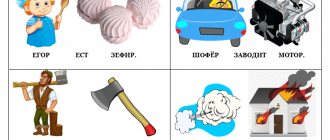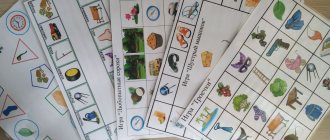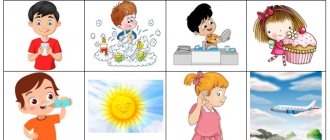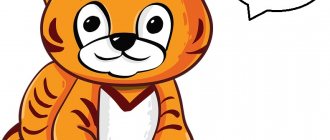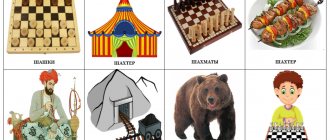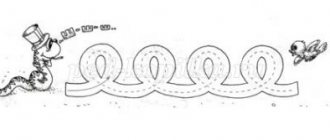Correct articulation of the sound “Z”
The sounds “З”, “Зь”, “С”, “Сь”, “Ц” are classified as whistling sounds as having similar articulation. To learn how to say the letter “Z,” let’s first clarify how the speech apparatus works.
When we pronounce the sound “Z”:
- the lips are slightly stretched, as if smiling;
- the tongue on the sides is pressed against the upper teeth, and at the bottom it rests against the lower incisors;
- a small gap remains between the rows of teeth;
- the soft palate blocks the air stream from exiting through the nose;
- the air passes along the tongue, creating a dull “C”;
- the vocal cords vibrate and “turn on” the voice, without which the sound of “Z” is impossible.
What happens when there is a defect in the reproduction of whistling sounds?
What difficulties may arise when working with the sounds З and Зь? Useful tips.
Advice one. If a child cannot make the sound Z, then the reason may be insufficient development of the organs of the articulatory apparatus.
Articulation exercises for whistling sounds will help cope with this problem. You will find a detailed complex of articulation gymnastics in step-by-step descriptions and videos in the article “How to teach a child to pronounce the sounds C and Сь.”
Tip two. If a child cannot make a groove in the middle of his tongue when pronouncing the sound Z, then most likely his tongue muscles are underdeveloped. Exercises will help us:
- Ask your child to smile widely (stretch their lips) and hold their lips in this position. If your lips are stretched, you need to stick your outstretched tongue out and blow on its tip. You will get a groove in the middle of the tongue. The exercise is carried out in front of a mirror.
- If the groove does not work, then ask the child to stick the wide tip of his tongue out. Place the edge of a teaspoon in the middle of your tongue. Having made a small depression in it, ask the child to blow air along this groove. You can blow on cotton wool or a thin strip of paper, then the result of the exercise will be clearly visible. As soon as the child can easily do this exercise, you can ask him to move his tongue behind his lower teeth (maintaining the position of his lips). The result is the sound S. When you add a voice to it, you get the sound Z.
- The exercise described above can be done with a glass vial (a glass jar or bottle from a pharmacy). Teach your child to whistle into a bubble so that the tip of the tongue moves slightly outward or touches the edges of the bubble. Air flows along the groove in the middle of the tongue and the result is a whistle. First, try whistling yourself in front of a mirror, and then show the exercise to your child. If the groove in the middle of the tongue does not work out for him, place a thin round stick along the tongue.
Tip three. If a child sticks his tongue out between his lips when pronouncing the sound Z
(therefore the sound is distorted), then do this exercise. Ask your child to stretch his lips into a smile and close his teeth tightly. And whistle like a pump ssssss. And then sing like a mosquito zzzzzzz. With clenched teeth, the tongue will automatically rest against the lower teeth, and the correct sound will be produced.
You will learn more about the methods of producing sounds S and Z from a video by a speech therapist about producing whistling sounds.
The sound Z appeared. Now we are faced with an important task - to automate this sound in the child’s speech.
The sequence of exercises to consolidate the correct pronunciation of the sound Z:
- 1. exercises with isolated sound,
- 2. sound in syllables,
- 3. sound in words
- 4. sound in phrases, poems, stories, dialogues, tongue twisters.
First we work with the sound Z, and then with its soft version - the sound Зь. Games, tongue twisters, nursery rhymes, poems, and pictures are selected for each stage.
Types of incorrect articulation of the sound “Z”
When the pronunciation of whistling sounds is distorted, it is called sigmatism; when it is replaced by other sounds, it is called parasigmatism.
There are several types of sigmatism:
- Labial-dental. With this defect, the lower lip stretches upward and the result is “B” instead of “Z” (“task” - “vada”).
- Side. The tongue on the sides, or only on one side, does not rest on the upper teeth, and the air disperses in the mouth, losing pressure and forming a squelching sound “HL” (“sunset” - “slurp”).
- Interdental. The tongue rests between the rows of teeth, creating a lisping sound.
- Nasal. The soft palate descends to the root of the tongue, exhaled air exits through the nose. This produces a nasal "X".
- Prizubny. The tongue rests on the half-closed teeth and does not allow the passing air to move freely, as a result you hear something between “D” and “Z” (“winter” - “dzima”).
- Hissing. The tip of the tongue moves towards the frenulum, it bends towards the upper palate, the lips are rounded and a hiss is obtained instead of a whistle (“lock” - “zhamok”).
Sequence of correction work
Sound production is part of speech therapy work with sound pronunciation, which takes place in stages. In general, the process looks like this:
Only sequential passage of all stages makes it possible to achieve the desired result and consolidate it.
Now let's talk about everything in order.
Preparatory stage
At the preparatory stage, the correct sound and articulation of the formed “Z” is demonstrated. Articulation and breathing exercises are performed to prepare the child to perform basic positioning exercises.
Sound production
There are several ways to set the sound “Z” for speech therapists:
Imitation performance
The child is explained how the organs of the speech apparatus should be located and move, and how “Z” sounds. He repeats after the speech therapist both the isolated sound and the syllables containing it. With this method of presentation, cards, layouts, and illustrations are used for clarity. This makes the process of sound reproduction understandable and conscious.
Mechanical method of installation
When staging sound pronunciation using this method, the position of the speech organs is corrected by auxiliary means, for example, probes, spatulas or fingers.
So, with an interdental defect, the tongue is moved behind the lower front teeth with a spatula; and in case of labiodental, the lower lip is held by a speech therapist.
Staging from reference sounds
Supportive sounds have a reproduction mechanism similar to the impaired ones, but are pronounced correctly by the child. Therefore, staging a problematic sound based on them brings good results. The references for the sound “Z” are “I” and “F”, as well as for “S”. Corrective work on “Z” begins after setting “C”. They differ only in that the voice is used to pronounce “Z”.
Setting "Z" from "I":
- we stretch our lips into a smile and pronounce a drawn out “I”;
- Without changing position, we only try to exhale air noisily;
- when we hear, even if not too acoustically pure, “S”, we translate it with our voice into “Z”;
- We invite the baby to put his hand on the neck and feel how it “buzzes”;
- strengthening the sound, we ring longer.
And pronouncing the sound “F” makes it possible to practice a correctly directed stream of air. You can also make the sound “Z” from “Sh” and “T”.
Setting “Z” from “W”:
- pull “W”;
- move the tongue towards the lower incisors until it stops;
- when we receive a whistling “C”, we connect the voice;
- imitate the sound of a mosquito.
Setting "Z" from "T":
- as you exhale, continuously pull “T”;
- continue and smile;
- the stronger the smile, the thinner the whistling “S” is produced;
- further - according to the well-known algorithm to “Z”.
How to evoke the sound Z by imitation?
In the absence of the sounds З and Зь or their replacement with other sounds, you can first try to evoke the sound З by imitation.
Ask your child to sing the mosquito song zzzzzz.
- Show what position the lips have (smile), tongue (wide with a groove in the middle).
- Pronounce the sound Z – “mosquito song” – slowly.
- Ask your child to repeat it.
Play mosquitoes with your child - reinforce the sound “z”. Remind your child how in the summer mosquitoes in the forest sing their song: “zzzz” and bother us. Let the child be a mosquito in the forest and sing the mosquito song “zzz”, and you will run away from him into the house and hide.
When playing with a group of children, one half of the children “walks in the forest”, the other pretends to be mosquitoes and rings “zzz”. Then the children change roles.
After the children ring like mosquitoes, show them the difference in the articulation of the sound C and the sound Z. Sit in front of the mirror. And compare the sounds s (“pump song”) and the sound z (“mosquito song”). Draw the children’s attention to the fact that the sound C—“pump song”—sounds quietly, and the mosquito song sounds loud—zzzz—and a voice can be heard. The mouth is the home of the voice. And when the voice loudly sings the song of a mosquito, even the walls of the house tremble. And you can feel it.
Demonstrate these unusual sensations to your child. First, place the child’s hand on your neck when you say the sound Z. Let him feel the vibration as you pronounce the sound “z.” Then ask your child to put one hand on the back of your neck, and the other hand on his neck, and sing the mosquito song “zzzzz” with him. Children usually really like this task, new sensations that are unexpected for them.
Compare with the sound C - “pump song”. Pull the ssss sound. Trembling - no vibration! Tell your child that the sound C is a dull, quiet sound, our voice sleeps. And the sound Z is loud, ringing, the voice loudly sings the song zzzzz.
Very often this exercise and explanation is enough for the sound Z to appear in the child’s speech.
Automation of the sound "Z"
It is not enough to just pronounce a sound; you need to learn how to use it in your speech. At the next stage after setting, the learned skill is consolidated. First in isolation, then in syllables, words, phrases and sentences.
To automate the sound “Z,” you can practice pronouncing it in poetry, tongue twisters, tongue twisters, riddles, and phraseological units.
For example,
poems with the sound "Z"
pure sayings starting with “Z”
tongue twisters starting with "Z"
And here are some more interesting riddles and phraseological units starting with the letter “Z” at the automation stage.
Puzzles:
Phraseologisms:
hack it on the nose, throw it in hats, it will heal like on a dog, kill the worm.
A speech therapy session on automating problem sounds will be more successful if it is organized in a playful way using color pictures, toys, cubes, lotto and other items.
Here are some ideas for automating “Z”:
- Ask your child to name the colors of the blocks. What color starts with " Z "? That's right, green . Let's add the green cubes separately. What toys contain the letter " Z " in their name? Bunny , bunny , dog Zina . It turns out that a hurricane destroyed their houses, and they decided to build one common house from green cubes. One day, while walking in a green forest, it started to rain. “Where are our zons ?” - the believers shouted . They rushed home, but the evil wolf Zaza was waiting for them . The little girls were not afraid; they invited the wolf to come and wait out the rain over a cup of aromatic tea with strawberry jam.
- Place the colored pictures in a row and let the child choose from them those that depict objects with the letter “Z”.
- You name the word, and the child repeats it in the plural (tooth-teeth, beast-beasts).
Regular practice is an indispensable condition for the development of any skill. Only by being determined to work methodically and with the support of a speech therapist can you help your son or daughter overcome the naughty letter.
Article:
Exercise “Angry Fly”
When a fly gets caught in a spider’s web, it buzzes: “Z-z-z...”.
Automation of the sound [z] in direct syllables ZA – ZA – ZA – ZA – ZA ZY – ZY – ZY – ZY – ZY ZO – ZO – ZO – ZO – ZO ZU – ZU – ZU – ZU – ZU
Automation of the sound [z] in reverse syllables AZZ – OZZ – UZZ – IZZ EZZ – ЁЗЗ – YuZZ – YaZZ
Automation of the sound [z] in intervocalic syllables AZA – AZO – AZU – AZY UZA – UZO – UZU – UZY OZA – OZO – OZU – OZY YZA – YZO – YZU – YZY
Automation of the sound [z] in syllables with consonant clusters ZNA – ZNO – ZNU – ZNY ZMA – ZMO – ZMU – ZMY ZVA – ZVO – ZVU – ZVY ZDA – ZDO – ZDU – ZDY
Automation of the sound [z] in words, the sound at the beginning of ZA: for-za-pad, for-mok, for-vod, for-law, for-kat, for-smell, for-gon, for-run, for -singing, for-howling, for-be, for-ti, for-ka, for-za-nat, for-bo-ta, for-ba-va, for-te-ya, for-vi-tok, for-ku -talk, for-guess, for-think, for-sing, for-ki-give, for-want, for-ki-nut, for-ki-sing, for-pull , for-o-hat, for-e-hat, for-run, for-give, for-yin-ka, for-pon-ka, for-bad-ka, for-vet-ny, for - yes-no-e, for-da-va-ka, for-bi-ya-ka, for-go-to-vit, for-go-tov-ka; ZO: Zo-ya, umbrella, umbrella-tick; ZU: tooth, tooth, tooth, tooth, tooth, tooth; PS: unsteady.
Automation of the sound [z] in words, sound at the beginning, with a combination of consonants Know, sign, ringing, call, heat, sound, bell, zna-mya, called, zna-tok, ring-thread, ring-cue , know, know.
Automation of the sound [z] in words, the sound in the middle ZA: va-za, ba-za, ko-za, na-zad, fa-zan, kazak, smear, e-go-za, me-du -za, mi-mo-za, y-ka-za-za, na-ka-za-za, po-ka-za, mo-za-i-ka, don’t-za-bud-ki, y-ka-za-ni -e. AZ: name, az-bu-ka, name-va-ni-e; ZO: bi-zone, wagon; HP: air-spirit; ZU: ve-zu, ma-zut, down-zu; PS: vo-zy, ta-zy, ko-zy, va-zy, ya-zyk, mu-zy-ka, mu-zy-kant, name-call; FROM: from-ba, from-gib, from-mump, from-tok, from-nan-ka, from-yes-no-e.
Automation of the sound [z] in words with these two sounds Tie, ring, arrogant, bark, cover up, splinter, travel
Automation of the sound [z] in phrases New umbrella, funny bunny, new basins, familiar music, familiar musician, hot day, ringing bell, dinner party, funny kitten, groovy goat, Zoya’s idea, dark nook, dental floss.
Automation of the sound [z] in sentences of 3 words Zoya has a goat. Zoya has an umbrella. Zoya buys the alphabet. Zoya asks riddles. Zoya's dad is a musician.
Automation of the sound [z] in sentences of 4 words Zoya knows a lot of riddles. Zoya is late for class. Zoya shows the alphabet to the bunny. Zoya's bunny's name is Zaznayka. Mom gives Zoya an umbrella.
Automation of the sound [z] in sentences of 5 words Pheasants drink water from a basin. Aunt Zoya rings the bell. Zoya is grazing a goat under an umbrella. They carry a lot of locks on the cart. Aunt Zoe doesn't have an umbrella. Zoya is a bully and arrogant bunny. There are mimosas and forget-me-nots in the vases.
Automation of the sound [z] in sentences of 6 words There are a lot of forget-me-nots and mimosas near the castle. Mom asks Zoya a riddle about a bunny.
Automation of the sound [z] in pure sayings For - for - for, for - for - for there is a goat tied here Z - zy - zy, zy - zy - zy the goat has little grass Zu - zu - zu, zu - zu - zu we untied the goat For - for - for, for - for - for the goat climbs into the garden Zu - zu - zu, zu - zu - zu we tied the goat For - for - for, for - for - for here the goat is tied
For - for - for, for - for - for goes Zoya's goat Zy - zy - zy, zy - zy - zy that goat has a curl Zu - zu - zu, zu - zu - zu I'll give the goat water to drink For - for - for, for - behind - behind the hut in the shade - goat
For - for - for, for - for - for goes the goat, goat - fidget Zoy - zoy - zoy, zoy - zoy - zoy the bunny walks along with the goat Zoo - zu - zu, zu - zu - zu Zoya leads the bunny and the goat
Automation of sound [z] in verse *** Two goats and two bison Trampled all the lawns.
*** Zoya has her own goat. The goat's name is Egoza. Zoya knows no peace with her goat Egoza.
*** Lisa's mom, Zina's mom We visited the store. They bought a bunny for Lisa, and a mosaic for Zina.
*** Zoya knows - sometimes a star falls from heaven. The starfall will surprise those who, when it is dark, do not sleep.
*** Winter has a lot of worries: Letting out snow drifts, blizzards, Sweeping the paths everywhere - No stopping by, no going in.
*** Znayka knows everything about the stars - He is building a spaceship. At sunset the starship will go to the star path. Will reach the given star And will blink to everyone from the darkness.
*** The bear forgets about his worries in winter, He sleeps under the howling of the blizzards. The snowfalls are falling and the snow is blowing, but the bear dreams until spring.
Automation of sound [z] in texts Ring A ringing bell rings. He calls Zoya to class. Zoya has the alphabet. She knows a lot of letters.
Caring housewife Zoya has a goat in her pen. The goat's name is Egoza. Zoya takes care of the goat. The goat always has water in its basin. On a hot day, Zoya grazes a goat under an umbrella.
Funny stars Stars shone in the sky. Zoya and Lisa pulled back the curtain and admired the starry sky. The stars winked at them. “What funny stars!” - Lisa and Zoya laughed. - “So far from the earth, but they can see us!”
Automation of the sound [z] in tongue twisters There are bison in the corral, and goats in the corral. Aunt Zoya will not forget to tell Zoya a riddle. There are basins on the carts, and two goats on the carts. At the hut there are mimosa, at the mimosa there are goats. Aunt Zoya gives Zoya an umbrella from the heat. Goats eat mimosas under the mimosa trees.
Automation of sounds in spontaneous speech
At the final stage, when all the steps of painstaking work on the unruly sound have been completed, it is introduced into spontaneous speech.
Try playing word games:
- Continue the phrase: “Today on the way home I...”; “I liked how...”; “I recently found out that...”
- Tell me what color is your mood. For example, pink - joyful and carefree; or gray - sad and gloomy.
- Thematic stories about how a bear lives in the zoo; why does the fox have such a beautiful tail; what a woodpecker is doing in the forest, etc.
Self-control is the key to successful work on problematic sounds
In order for all the work done to be crowned with success, it is necessary to take into account such a factor as the child’s ability to control his pronunciation. Classes with a speech therapist and communication with parents are only part of the time where control is established over the child’s speech. The rest of the time, including when communicating with peers, the child must learn to monitor his speech himself.
To prevent this from becoming an annoying chore, motivate him to overcome his speech impediment, support him during failures, and praise him for small victories over himself. Your baby will definitely succeed, don’t doubt it.
As well as the fact that he will grow into a purposeful, open-to-communication person.
Stories and fairy tales with the sound Z for classes on ZKR with preschool children.
Bunnies (Lithuanian fairy tale)
Bunnies were born to a hare. The father looked at his children and said to them: “I have a mustache, and you already have a mustache!” So, that means, get your own food. Since then, the little hares, as soon as they are born, live alone, without parents, in a dark forest: they have neither a nest nor a hole. But everyone with a mustache, everyone from the first days can get their own food.
Boy and goats.
Once upon a time there was a boy, and he had three goats. During the day the goats galloped and jumped on the rocks, and by night the boy drove them home. One evening the boy began to drive them home, and the goats ran into the cabbage field, and there was no way to get them out of there. The boy sat down on a hillock and began to cry. A hare walked past. - Why are you crying? – the hare asked the boy. “I’m crying because I can’t drive the goats out of the field,” the boy answered. “I’ll drive them out,” said the hare. The hare began to drive out, but the goats did not come. The hare sat down and also cried. A fox walked past. - Why are you crying? – the fox asked the hare. “I’m crying because the boy is crying,” says the hare, “And the boy is crying because he can’t drive the goats out of the field.” “Calm down, I’ll drive them out,” said the fox. She began to drive out, but the goats would not come. The fox sat down here and also began to cry. And so the wolf drove him away, but he didn’t drive him out either. A bee was flying here. He sees that they are all sitting and crying, and says: “I’ll kick them out.” Then all the animals and the boy stopped crying and began to laugh at the bee. How will she drive out the goats when they all couldn’t cope! But the bee flew to the cabbage field, sat on the goat, and began to buzz. - Zhzhzhzhzh! Zhzhzhzhzh! Zhzhzhzh! How the goats will start running! And they ran home from the field.
Monkey Ruza. The author of the story is A.I. Maksakov. From the book “Development of correct speech of a child in the family” (Publishing house Mozaika - Synthesis, 2011).
“Dad brought Zoya a monkey from Africa. Zoya named the monkey Ruza. Ruza knew how to jump funny and imitate Zoya's friends. Zoya taught Ruza to answer the doorbell. In winter, Ruza fell ill. Zoya took Ruza to the doctor, gave her various herbs, and fed her bananas. Thanks to Zoya’s care, Ruza recovered.”
Ask your child questions about the content of the story. Ask them to find words with the sound Z in the story and make up their own sentences with them.
The story "Girlfriends". Author – M.F. Fomicheva. From the book “Educating Children to Pronounce Correctly.”
“Zoya, Lisa and Aza are friends. Friends gathered at Zoya's. Zoya, Lisa and Aza play together. The Muse doll is put to bed. They go for a walk with a funny bunny. Mom called Lisa home. Azu was also called. Zoya was left alone. Zoya's teeth hurt. Zoya tied her teeth and sits. Lisa found out about this. Zoe brought a mosaic. Aza also found out. I brought Zoya some forget-me-nots. Zoya put forget-me-nots in a vase. Lisa, Zoya and Aza began to play mosaic. They made a beautiful mosaic pattern! Then they asked riddles:
As soon as she got down to business, she sawed and sang. She ate, ate oak, oak, broke a tooth, a tooth. (Saw)
Kuzma is knotty and cannot be untied. ( Chain)
He himself doesn’t know the days, but he points them out to others. (Calendar)
The friends had fun for a long time. Zoya forgot about her bad teeth.”
Ask your child questions about the content of the story. Make sure that he pronounces the sound Z correctly in his answers.
An outdoor game to reinforce the correct pronunciation of the sound Z “Find out by voice.”
Authors: E.I. Radina, V.I. Rozhdestvenskaya.
This game develops children's auditory attention. A circle is drawn on the ground. Children run around the playground. At the adult’s signal, “One, two, three – run in a circle!” they gather in a circle.
The driver is selected. He is blindfolded. He turns his back to the children.
All the children say:
“We frolicked a little, everyone settled down in their places. Guess the riddle, Find out who called you!”
The adult gestures to one of the children, who says: “I’m calling you!” The child driver guesses who called him: “Vova called me? Katya called me?”
If the child guessed who called him, then he changes places with this child. And the other child becomes the driver.
If the child did not guess who called him, then he guesses again in the next game.
In the game you can change your voice, speak in a squeaky high voice or a thick bass voice. It's always interesting and unexpected in this game how players will change their voice.



